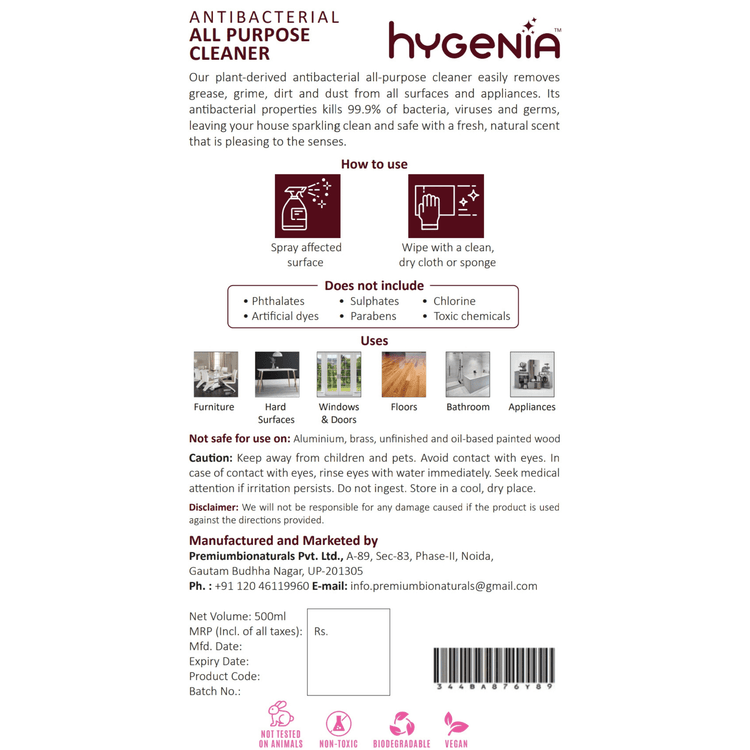Let's face it – cleaning your home is a never-ending task that can sometimes feel like an uphill battle. But with so many cleaning tips and tricks available online, it can be hard to tell fact from fiction. The truth is, house cleaning myths are everywhere, and if you’ve ever spent extra time scrubbing or tried a “miracle” solution that didn’t work, you’re definitely not alone.
Misinformation can result in surfaces not being properly cleaned, which may harbor bacteria and allergens, or cause damage to delicate materials. To help you achieve a truly clean and healthy living environment, we are here to debunk the top 6 house cleaning myths and provide you with reliable, effective cleaning facts that you can trust.
Myth #1: "Bleach Cleans Everything!"
While bleach is an excellent disinfectant, it is not an effective cleaner. Bleach kills bacteria and viruses but does not remove dirt or grime. For a truly clean surface, use a proper cleaner first, then disinfect with bleach.
-
This two-step process ensures that surfaces are not only sanitised but also free of visible dirt.
-
When it comes to clothing, bleach can effectively whiten and disinfect white clothes, but it can also damage colored fabrics by causing discoloration or weakening fibers.
-
Always use bleach carefully and only on recommended materials to avoid ruining your garments.
-
Bleach is not an all-purpose cleaner, what many people believe.
While bleach can kill germs, it’s not your all-in-one solution. Use it wisely, but don't expect it to handle everything from soap scum to greasy kitchen counters.
Myth #2: “Feather Dusters Remove Dust”
Feather dusters often spread dust around rather than capturing it. Using microfibre cloths or electrostatic dusters is more effective in trapping and removing dust from surfaces.
-
A microfibre cloth is a much more effective tool for trapping and removing dust from surfaces.
-
Microfibre traps dust particles within its fibers, ensuring they are removed from your home environment.
-
Unlike feather dusters, which can release dust back into the air, microfibre cloths hold onto the dust, preventing it from resettling on surfaces.
-
For the best results, lightly dampen the cloth before dusting to help capture more particles and reduce static cling.
Feather dusters don't actually remove dust, they simply move it around.If you’ve been relying on feather dusters, it’s time for a change. For truly dust-free surfaces, ditch the feathers and grab a microfibre cloth.
Myth #3: “Newspaper is the best streak-free cleaner for glass!”
If you're cleaning your windows, just stick to paper towels. Not only is newspaper lighter, which means it's more likely to tear up if you use too much (or too little!) cleanser, but it's covered in ink. That means not only could it leave streaks—if, say, it tears and you end up rubbing the glass with your skin—but it could stain your windows.
-
A microfibre cloth or a squeegee is a better option for clean, streak-free windows. These tools are designed to remove grime and leave glass surfaces sparkling.
-
Additionally, using a dedicated glass cleaner or a vinegar and water solution can help achieve the best results.
-
For a truly streak-free finish, wipe in a consistent pattern, such as up and down or side to side, rather than circular motions.
Myth #4: “The more cleaning product you use, the better.”
We’ve all been there – you’re cleaning your home, and you want to make sure everything is extra clean, so you add a little extra cleaning product, just to be sure. But the truth is, using too much cleaning product can actually be counterproductive.
-
When you use too much cleaning product, it can leave a residue on surfaces, which can actually attract more dirt and dust.
-
Not only does this make your surfaces look dull and dirty, but it can also make them harder to clean in the future.
More soap doesn't mean a deeper clean — it can actually make cleaning harder.
Using excessive soap doesn’t guarantee a cleaner surface; in fact, it can leave a residue that attracts more dirt. It’s essential to use the recommended amount of cleaning product to achieve optimal results without unwanted buildup.
Myth #5: “Professional carpet cleaning? No way! It'll shrink my carpet!”
When it comes to carpets, there are loads of misconceptions. Let’s tackle one of the biggest carpet cleaning myths.
-
For some reason, a lot of people are convinced that getting their carpet professionally cleaned will shrink the carpet, pulling it away from the walls and generally making it look yuck.
-
But really, there's no need to worry, especially with newer, modern carpets.
-
Regular maintenance prevents the accumulation of dirt that can wear out your carpets prematurely.
-
Additionally, using a high-quality vacuum with strong suction and proper filtration helps remove more dirt and allergens from your carpet, contributing to a healthier indoor environment.
Avoid falling for carpet cleaning myths and take it easy on the shampoo. Gentle care and occasional deep cleans will keep your carpets looking fresh.
Myth #6: “Scrubbing Harder Cleans Better”
Scrubbing too hard can damage surfaces and spread dirt around.
-
Use appropriate cleaning tools and products, and let them do the work.
-
Gentle scrubbing combined with the right cleaner is often more effective and preserves the integrity of your surfaces.
-
Using excessive force can scratch finishes, wear down protective coatings, and even cause permanent damage.
-
Instead, use a soft-bristle brush or a non-abrasive sponge, and allow the cleaner to penetrate and lift the dirt with minimal effort.
Effective Cleaning Practices
To maintain a truly clean and healthy home, consider the following practices:
-
Use Appropriate Cleaning Agents: Select cleaning products suitable for the specific surfaces and tasks. Choose our Hygenia’s Antibacterial All Purpose Cleaner perfect for your house cleaning.
-
Regular Maintenance: Establish a consistent cleaning schedule to prevent the buildup of dirt and grime. Regular upkeep reduces the need for intensive cleaning sessions.
-
Proper Ventilation: Ensure adequate airflow during and after cleaning to dissipate fumes from cleaning agents and reduce indoor air pollution.
-
Protective Measures: Wear gloves and, if necessary, masks when handling cleaning products, especially those containing strong chemicals. This practice safeguards your health during cleaning activities.
Frequently Asked Questions:
Q1) How do you protect yourself before cleaning?
A) Use goggles and rubber gloves to protect your eyes and skin when using the product.
Q2) How can we maintain cleanliness?
A) Regular dusting can maintain cleanliness.
Q3) What would happen if we do not clean our house daily?
A) Worsens Allergies as the Dust Mites can increase.
Q4) Why we should clean our house?
A) Regular cleaning keeps your home free of dust and makes it a much better environment overall for your family, particularly anyone with allergies.
Cleaning is an important part of maintaining a healthy and happy home, but it’s important to separate fact from fiction. By debunking these common cleaning myths, you’ll be able to clean more effectively and efficiently. Remember, cleaning takes time and effort, but the results are worth it. And if you’re looking for safe, effective, and natural cleaning products to make your cleaning routine even better, be sure to explore our Hygenia Homecare Collection at Premium Bionaturals. A clean home is a healthy home!














